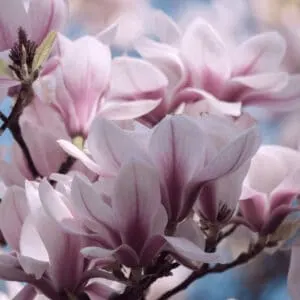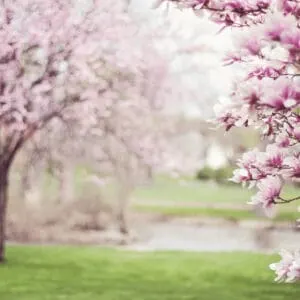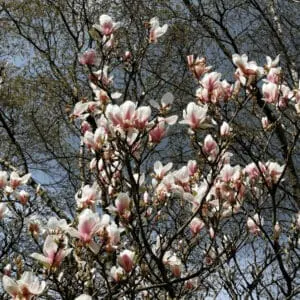Magnolia tree care is not difficult if you follow the care guidelines outlined in this article.
I am growing a Magnolia tree for over 20 years now.
If you are looking to plant only one iconic tree in your garden, your choice has to be the beautiful Magnolia tree.
This ancient tree has been known through the ages and has been the subject of poetry, music, movies, and art.
The Magnolia genus offers over 200 different varieties.
It is a southern favorite in the USA.
Mississippi and Louisiana have designated the flowers as their official state flowers.
Magnolias create a focal point in your garden with their stunning glossy leaves, colorful flowers, and delightful fragrance.
Magnolia trees require little maintenance, and once established can live for up to 100 years or more.
I will chat about the most common variety – Magnolia Grandiflora, but will also give you info about other varieties that may be better suited to your specific garden.
So, put on your gardening gloves, and let’s get started.
Magnolia Tree Care
Plant your Magnolia tree in full sun where it gets at least 6 hours of full sun. The soil must be slightly moist and well-draining using peat, perlite, and humus. Water twice per week in cool climates and 3 times per week in hot climates. Temperate conditions are best. Humidity should be 30-50%. Fertilize in spring using a fertilizer high in nitrogen and feed 1.6 oz (45g) for every inch of trunk diameter.

Magnolia Tree Care
Table of Contents
Magnolia Tree Care Guide
Soil
Magnolia trees enjoy rich, moist, well-draining soil. Adding peat, humus, and perlite is recommended for younger trees. Neutral to acidic soil is best. Mature trees will tolerate most soil types. Avoid heavy clay-type soils if possible.
For the best flowering and growth, your magnolia tree requires rich, organically fertile, moist garden soil.
If you are preparing a spot for a new tree, purchase some all-purpose soil from your local nursery and dig it into your hole.
You can also make your own compost at home in a home-making compost kit.
If you feel that your garden soil is not rich enough, add mulch, composted leaves, or grass cuttings to increase the nutrients.
Moist soil means damp after watering, but it also means well-draining. Water should not accumulate and stagnate at the roots of the tree.
This will cause the roots to rot and your tree will die.
Drainage can easily be improved by adding peat and perlite to your soil.
This aids in aeration and allows the water to soak through.
Once your tree is established, it will become more tolerant of sandy soils and even heavy clay soils.
Water drains faster out of sandy soils. Heavy clay soils tend to retain water.
Of all the soil types, magnolias enjoy chalk soil the least
New gardeners sometimes tend to get confused about the terms neutral, acid, and alkaline soil.
While most plants do well in average garden soils, it is useful to know which type of your soil your plant is happiest in.
The acidity of your soil is measured by using a PH kit.
You can easily purchase a PH testing kit from your local nursery or online garden store.
Once you have followed the instructions you will get a PH reading.
A reading of 7.0 indicates neutral soil. A reading of under 7.0 indicates acidic soil. Over 7.0 means that your soil is alkaline.
Magnolia trees do best in soils that are neutral to slightly acidic. Look for a PH value of 6.5 to 7.0.
If your reading is way out, you may need to adjust the PH of your soil. If your reading is in the correct range, great! You won’t need to worry.

There are over 200 different Magnolia varieties
Light
Magnolia trees enjoy full sun to part shade. Plant where it will get at least 6 or more hours of sun per day. Some varieties are more tolerant of shady conditions.
Magnolia trees do best in full sun to part shade.
South-facing gardens are ideal as they offer sun throughout the day. In gardening terms, full sun is anything from 6 hours or more per day.
You also need to ensure that your garden is not being thrown into shade by other large trees, neighboring walls, hedges, or screens.
West-facing gardens are also suitable as they get hot in the afternoon due to the evening sun.
Some species of magnolia trees that tolerate part shade to semi-shade will grow in east-facing gardens.
If you have a north-facing garden, you have loads of shade. Don’t despair. Magnolia trees will grow but may not flower as prolifically and may not be as dense.
If you are adamant that you have to have a magnolia tree in your north-facing garden – Magnolia stellata is the hardiest of all magnolias and the best variety to choose from.
Watering
For young magnolias, water twice per week in cool climates and three times per week in warmer climates for the first six months. After that water weekly. Mature trees require infrequent watering. If the conditions are exceptionally hot and dry, water to ensure that the soil is moist.
Magnolia trees require average watering conditions. That always sounds good – you don’t need to stress too much about watering routines.
That being said, your tree does best in moist soil and you do need to water from time to time.
Magnolias need about one to two inches of water a week. In average climates, this is usually obtained from rainfall. If you are faced with very dry hot periods, you will need to water your plant.
Plan on watering once a week during the first two growing seasons. For the following few years, plan to water once every two weeks. Mature trees require infrequent watering.
Be vigilant of your soil type as this affects the amount of water that the roots will be able to absorb.
Sandy, loose soil will drain faster and less water will be absorbed by your tree. Plan on watering more frequently in smaller amounts.
Clay-type soils retain water and you need to ensure that it does drain out. If not, the roots will rot and the plant may eventually die. Add peat or perlite and water less frequently.
Do not over-water your young magnolia tree.
If your soil is dry and the weather is hot, adding a layer of mulch into your soil around the tree is a great way to retain water.
Magnolia trees are not tolerant of extended drought conditions and you will need to water well if you find yourself in this situation. They are equally not tolerant of extreme wet conditions.
Once you have a majestic, towering tree established in your garden, watering it may become a mission! At this stage, it will probably be hardy enough to survive average conditions and some extreme conditions.
You can, however, enjoy some me-time alone with your tree and a hose pipe.
Magnolia virginiana, commonly known as Sweet bay, is one variety that tolerates wet soil better than others.

Magnolia flowers are the official state flowers of Mississippi and Louisiana
Temperature
Magnolia trees enjoy a temperate climate. They are not frost tolerant and do not like extreme dry heat. Very cold temperatures of below 23°F (-5°C) can cause extreme damage.
Magnolia is hardy to UDSA zones (6)7) from Florida to Mississippi states Oregon State University.
Magnolia trees enjoy a temperate climate.
They will not survive if temperatures drop below 23°F (-5°C). They are also not ideally suited to extremely hot and dry climates.
Frosts can damage spring flowers and evergreen leaves in the fall. Trees may recover if the damage is not extensive and ongoing.
Humidity
Average humidity is best for your magnolia tree. This means a reading of 30% to 50%. Very damp, high humidity or very dry, low humidity, conditions are not ideal.
Magnolia trees enjoy average humidity. They are not suited for rainforest or desert-type conditions.
They are best suited for USA hardiness zones 7 to 9.
However, as there are so many varieties of magnolia, you will find certain types that are better suited to cooler, dryer, or warmer climates.

Magnolia are large growing trees
Fertilizer
Magnolia trees enjoy a high nitrogen component. Look for indicators that are 20-5-10 or 12-4-8. Fertilizing is not necessary for mature trees. Younger deciduous trees can be fertilized in spring or at the end of fall. Evergreens can be fertilized just before winter.
The roots of magnolia trees are very shallow and over-fertilizing your soil can cause damage to the roots.
Care must be taken to provide the correct amount and the correct type of fertilizer if you want spectacular flowers with a beautiful fragrance.
The best fertilizer for your magnolia tree is a mixture that contains a lot of nitrogen.
When you buy fertilizer, you will see a set of three numbers on the package.
They read something like 20-5-10 or 12-4-8.
These numbers indicate the ratios of nitrogen, phosphorus, and potassium in the mixture.
As you can see from these numbers, the first number is the higher of the three.
That indicates a high component of nitrogen, which is just what your magnolia tree wants.
Because your tree will grow over the years, you will have to adjust the amount of fertilizer you give it.
A good guide is to calculate the tree trunk diameter in inches. Then feed it 1.6 oz (45g) for every inch.
You may feel awkward wrapping a tape measure around your tree, but give it a try!
The best time to fertilize is in spring before new leaves begin to emerge. You can also fertilize towards the end of fall when the leaves have dropped off.
If you have an evergreen variety, fertilize a few weeks before the cold winter sets in.
You don’t want to dig randomly around your tree to create holes for the fertilizer! The roots are very shallow and lie just underneath the surface. Digging can easily damage or destroy them.
So what do you do? The first option is to lightly dig up the top inch or so of soil around the tree trunk.
Then spread the fertilizer evenly onto the ground around the trunk of the tree. Water well. This will allow the fertilizer to sink into the ground.
Try not to do surface feeding before heavy rainfall, as heavy rainfall may wash away all the fertilizer.
If your soil is a clay-type, this method is not ideal as the fertilizer will not be absorbed into the soil. You can deep-feed by creating small, deeper holes around the far edges of the roots.
Start about 4 feet (1.2m) away from the trunk and make narrow holes that are about 6 inches (15cm) deep. Fill them with a slow-release liquid fertilizer.
More mature trees become very hardy and will grow without any planned feeding routine.
But, there is no harm in giving your mature tree a boost from time to time.

A Magnolia tree can live for more than 100 years
Magnolia tree tips & tricks
- A full-grown magnolia tree is a majestic sight in a garden!
- Magnolia grandiflora trees do best in full sun. Your south-facing and west-facing garden is the perfect spot.
- Magnolia grandiflora can grow very large over the years. Some spread as wide as 40 feet (12m). This makes them a stunning focal point standing alone in the center of a garden.
- Make sure you have loads of space around your young tree. Roots are shallow and will spread far when the tree is mature. Choose a spot that is away from other trees, buildings, and structures.
- Don’t create a footpath that will be close to the tree when it is young. Foot traffic can damage the shallow roots. Once your tree is established, you can certainly have a lovely walkway to a bench or picnic table under the tree. A perfect getaway spot in your garden.
- Keep in mind that the spread and dense shade that a mature tree creates will make it difficult to plant lawn underneath the canopy, close to the trunk.
- You may have to settle for a gravel or crushed-stone ground cover. With some thought and planning, this can be a very attractive feature in your garden.
- Smaller varieties of magnolia trees are ideal to plant next to a patio or deck where the lovely fragrance will waft into your outdoor breakfast or afternoon tea nook.
- Many Magnolias shed leaves all year round. So be prepared to do some cleaning up on a regular basis!
When to plant your Magnolia tree
Evergreen magnolias are best planted in early spring. Deciduous magnolias are best planted when they are dormant. This means planting in late fall or winter in warmer climates, and planting in early spring in colder climates.
How to plant your Magnolia tree
Choose a spot that will allow your tree to grow to its full potential. Magnolia trees can grow very large! They do not take well to replanting, so it is best to find the perfect spot to start with.
Choose a spot with rich, moist, well-draining soil that gets full sun.
Remove your plant carefully from the container and shake off excess soil. Remove all the soil, if possible, to expose the top 2 inches (5cm) of the rootball.
If the rootball is well established and dense you need to cut into it to allow the roots to grow when they get into the ground. Place the plant onto a clean work surface. Using a sterile knife, make a few, deep 1 inch (2.5cm) cuts down the sides of the rootball.
Unlike many plants where we cover the rootball entirely, magnolia trees do better when part of the roots are exposed after planting.
To do this, dig a hole that is one and half times as wide as the rootball. Dig it to be one-quarter smaller than the depth of the rootball. This will allow the top section that we exposed to remain above the ground.
Water your hole well and dig in humus, compost, or add liquid nitrogen fertilizer.
Place your plant into the hole and ensure that the top section of the roots are exposed above the surface level of the soil.
Fill in the hole with soil. Pack down lightly to remove air pockets but do not pack too firmly.
Ensure that the top section of the roots are exposed. Then, lightly place a layer of mulch over these roots. Water very well.
In cold climates, water twice per week for the first 3 to 6 months. In warmer climates, water three times per week for the first 3 to 6 months. You can then water weekly during the growing season.
Magnolia tree: Growth
A Magnolia is your classic tree. It has a thick straight trunk and a dense spreading canopy of leaves and flowers.
Some varieties are evergreen and remain green all year round. Others lose their leaves in the fall.
Leaves are a glossy dark green with a leathery feel.
The flowers come in a variety of colors. Magnolia grandiflora offers creamy-white blooms that are a cup shape. They grow to be about 8 inches (20cm) across. Flowers are on show from late spring, thru summer, and into the fall.
The flowers are followed by seedpods that have a cone-like shape. The seeds inside are a rose-red color and hang on silky threads when the pods open.
A fully mature tree can grow as tall as 60 feet to 80 feet (18m to 20m) and as wide as 30 feet to 50 feet (9m to 15m) according to the University of Florida.
A truly imposing sight!
There are many varieties of magnolia. They offer breathtaking flowers that are light pink, dark pink, bright yellow, pale yellow, and even purple in hue.
Many varieties grow as smaller trees and can even be grown as a shrub or bush.
Pruning your magnolia tree
For gardeners who enjoy a hands-off approach, you will be happy to know that it is not necessary to prune your magnolia tree.
If you do want to get hands-on, pruning a young tree will definitely keep it in good shape. It will also encourage new growth and improve the overall health of your tree.
Note that pruning should only be done on young trees. Mature trees do not recover well from pruning. You may cause fatal wounds that will permanently damage branches.
When it comes to magnolia trees, trimming is usually better than heavy pruning.
Evergreen trees should be pruned from mid-spring to late spring. Deciduous varieties can be pruned or trimmed from mid-summer to early fall.
Take a look at your tree and shorten any branches that are becoming too long. Look for branches that are disturbing the natural shape of the tree and trim them off. This will help to maintain the shape you want as it grows.
Trim off lower branches to encourage a clean bare truck as the tree matures.
If a branch appears to be weak or damaged, remove it gently without disturbing branches around it.
Try to remove a branch that is rubbing against another. This can cause wounds that will be more easily infected by pests and disease.
Always use clean, sharp cutters or trimmers. Avoid heavy-duty shears as they cut at random and are not suited for magnolia trees.
If in doubt – don’t prune! Trim less than more, or not at all.
Propagating your Magnolia tree via seeds
Magnolia trees offer prolific seeds that fall under mature trees. They are great favorites for doves, quails, woodpeckers, squirrels, and other small creatures.
You can also collect magnolia seeds and use them to propagate other magnolia trees.
If you don’t have access to a magnolia tree, you can easily buy packets of seeds from a local nursery or farmer’s market.
You will need to be patient. Propagating from seed is a slow process that requires care and much time.
Soak the seeds overnight to loosen the coatings. They should float off, or you can give them a light scrub to remove them.
Scarify the seeds. That doesn’t mean that you scare them! You give them a rub with a light sandpaper. This will roughen up the seed, remove the protective oil and make it easier for the seed to open up and sprout.
Allow the seeds to rest for 3 to 6 months but not dry out. (Yes, I said you need to have patience!). Mix them with peat or a seed-starting mix. Place the mix into a plastic container and then into the fridge. You can also keep them in a seed tray that is placed into a cold frame.
Once the seeds root, you can carefully plant them into small pots. Bury each seed completely into the soil and cover with a rich humus-compost. Keep your pots very moist and out of direct sun.
After a few weeks, you should see the leafy sprouts start to appear above the soil. You can then transfer them into the ground. For this, you can follow my section for planting into the ground.
Propagating your Magnolia tree through stem-cuttings
Using stem cuttings to propagate a magnolia tree is another option. It also takes less time and is easier to do as you can see progress as the tree grows.
Plan to do this in summer or autumn. Prepare a clean sterile knife and a clean working surface. You can use a diluted alcohol solution to wipe down your tools and surface.
Prepare small pots with a rich soil. Add perlite, peat, and humus. Water well. Poke a hole into the middle of each pot in preparation for the seedling.
Cut off 6 inch to 8 inch (15cm to 20cm) pieces from the growing tips of branches.
As you cut off each piece, place them into a container of clean water.
Working with one at a time, gently remove the upper leaves on the cutting.
Make a vertical slice into each stem end. Make your cut about 2 inches (5cm) long. Dip the stem into a rooting hormone solution.
Plant into the pot.
Fill the hole with soil and pack down loosely.
Place a layer of mulch on the top. Water well. Ensure that your pots have drainage holes and that the excess water can run out. If the roots stand in water for too long, they will get rootrot and your plant will die.
Cover the pots with plastic to keep in the humidity.
Place the small pots in indirect light, not in direct sunlight.
Not all stem cuttings will survive and grow.
Plan to make at least 6 to 8 to ensure that you have success!
Plant each cutting into its own pot to give the roots ample space to grow downwards and horizontally.
When you see that your plants are growing new leaves and are becoming stronger, you can replant into your permanent garden spot.
Different varieties of Magnolia trees
- Magnolia ‘Black Tulip’ – offers the darkest of all the magnolia flowers, in a stunning deep burgundy. Flowers are tulip-shaped and bloom in spring before the foliage emerges. A magnificent sight in any garden.
- Magnolia ‘Butterflies’ – offer bright yellow flowers and grows as an upright, pyramidal shrub. Ideal for smaller gardens.
- Magnolia ‘Daybreak’ – an award-winning variety that blooms with rosy-pink flowers in mid to late spring. It grows as a smaller tree and is ideal for smaller gardens.
- Magnolia ‘Ann’ – grows as a shrub or small tree, perfect for smaller gardens. It offers red-purple flowers with pale pink insides.
- Anise Magnolia – grows as a medium-sized tree. It is also known as the Willow-leafed magnolia. Produces beautifully scented white flowers in early spring.
- Magnolia ‘Galaxy’ – small deciduous tree offering an abundance of dark pink flowers with pale rose insides.
- Magnolia ‘Ivory Chalice’ – as the name suggests, the beautiful cup-shaped flowers are an ivory color. They emerge on bare branches, creating a perfect photo opportunity for your show-off social media post.
- Magnolia ‘Gold Star’ – has creamy-yellow flowers that form a star shape. Blooms in mid to late spring.
Magnolia trees: Pests to look out for
Magnolia trees are not subject to serious disease or pest problems. However, they may from time to time be exposed to some undesirable pests that you can look out for.
Here are some of the pests that can attack your plant.
Magnolia scale will feed on the sap in the trunk and branches. This causes branches to show stunted growth or even die. Prune back infested branches and then spray surrounding branches with a solution of insecticidal soap.
Honey fungus is a creepy plant that grows like a mushroom. The problem is that, underneath the ground, it is sending out masses of tough fungal roots that spread and kill the roots of your magnolia tree.
If you spot what looks like mushrooms or honey fungus, you do have a problem, it is not easy to get rid of.
You can carefully dig underneath them and try to remove as much of the root system as possible.
You can also prune infected roots of your magnolia tree. Spraying with certain herbicide products can help, although not proven to be completely effective.
Capsid bug is another unwanted pest. They look like small beetles with a diamond-shaped pattern on their backs. They burrow into the tree and destroy the tissues of leaves, branches and flowers. You can spray with a pyrethrin based pesticide.
Common problems with Magnolia trees
Leaf scorch or leaf burn
If the foliage of your magnolia tree is looking wilted or discolored, it may have leaf burn or leaf scorch. You may even find that the leaves turn black and drop off the tree. This is a condition that is caused by excessive heat, frost, or strong winds.
Leaf scorch can also occur when the leaves lose water faster than the roots can suck it up from the soil.
Some of these conditions can be controlled to a small extent. If you have a young tree that is exposed to harsh wind, consider setting up a windscreen until the tree grows strong enough to withstand the windy conditions.
Adding a thick layer of mulch will help the soil to retain water during abnormally dry conditions. Make it as deep as 2 inches to 4 inches (5cm to 10cm) if possible.
Leaf edges look brown or burned
This could be a sign of over-fertilizing also known as fertilizer damage. Because the roots of the magnolia tree grow very close to the surface, over-fertilizing can cause more damage than it would with other types of trees.
A symptom of over-fertilizing is leaf edges that turn brown and look burned. This is caused by the salt in the feed. If you are fertilizing a lot, the salt will build up in the soil and you will get salt damage.
Stop fertilizing your tree. If possible, try to water the soil very well. Fresh water can help to dilute and wash away the built-up salt content.
Magnolia Tree fun facts
If you enjoy trivia, read on for some fun facts.
The genus is named after the French botanist Pierre Magnol, who lived in Montpellier, France, between 1638 and 1715.
The State of Louisiana designated the tree’s flower as the official state flower in 1900.
Mississippi is known as The Magnolia State, and the flower appears on its bicentennial commemorative quarter.
A Magnolia tree planted by USA president Andrew Jackson in 1828 lived and bloomed for 190 years. It was taken down in 2017 as it was considered to be in danger of falling.
A song titled “Sugar Magnolia”, released on the 1970 album American Beauty was recorded by the Grateful Dead.
The iconic movie Steel Magnolias, from 1989, uses the magnolia as a reference to women who are as beautiful as magnolia flowers but are tough as steel.
The Magnolia family is one of the oldest known flowering plant families. Some fossils are over 60 million years old.
Magnolia trees are known to symbolize perseverance, beauty, nobility,
endurance, joy, health, and a love of nature.
Magnolia Tree medical uses
Did you know that the bark and flower buds of magnolia trees are used as herbal medicine?
Parts of the tree can be used to cure digestive problems, hay fever, sinus pain, runny nose, stress, and depression. It can improve sleep and aid toothache.
That being said – proceed with care if you want to eat your magnolia tree! Ensure that you wash petals carefully and that they were not exposed to chemical insecticides.
You can boil the petals to make a relaxing, soothing tea. You can even throw them into a fresh salad to add fragrance, color, and an exotic taste.
For other remedies, purchase commercially prepared extracts from your health store.

Daniel has been a plant enthusiast for over 20 years. He owns hundreds of houseplants and prepares for the chili growing seasons yearly with great anticipation. His favorite plants are plant species in the Araceae family, such as Monstera, Philodendron, and Anthurium. He also loves gardening and is growing hot peppers, tomatoes, and many more vegetables.


